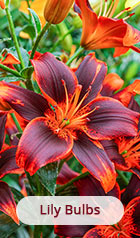Because many have plumes that keep their charming look well into the winter season, they provide many months of display when the rest of the garden has faded. Ornamental grasses are available in a range of hues and heights and can be used in a variety of ways--from lining walkways, to
planting in containers, to incorporating into mixed
perennial flowerbeds. Ornamental grasses are easy to care for and deer tend to avoid many varieties, so these are the perfect low-maintenance plant for a busy gardener. Look for our varieties of ornamental grasses for sale and brighten your garden this season!
How to care for ornamental grasses:
Ornamental grasses are some of the easiest-care plants in the landscape. Because they thrive in dry soil and don't require heavy nutrients, they rarely need to be fertilized. Deer, rabbits, and other animals avoid ornamental grasses, and these plants are quite resistant to insects and other pests. You should water your grasses every few weeks after planting as they become established. Every few years, take time to divide and replant your grasses.
When to plant ornamental grasses:
Ornamental grasses should be planted in springtime, along with other perennials. Planting in spring gives the grass time to settle in before cool weather sets in. Unlike grass used in lawn and sodding purposes, ornamental grasses are best planted as established, rooted plants, not as seed.
How to plant ornamental grasses:
Planting ornamental grasses is just as simple as planting any other potted perennials. If you have poor soil quality, amend the soil with some compost. Ornamental grasses can be planted at the same depth at which they're rooted in containers. Make sure to water in your grass well after it is planted, and press any air pockets out of the planting site.
Where to plant ornamental grasses:
Most ornamental grass varieties perform best in sunny locations. Some can survive partial shade, but flowering varieties will produce fewer blooms and the plants may look leggy. Luckily, ornamental grasses are some of the best plants for handling drought and heat, so you won't need to worry about their survival in the sunnier locations of your yard.
Instead of using ornamental grasses in shaded spots, put them front and center in sunny beds or standalone plantings. Ornamental grasses create a striking look when planted in clumps, so choose a selection of taller grass and pair with a shorter variety or some sunny perennials.
How to divide ornamental grasses:
Just like turf grasses, ornamental grasses and pampas grasses divide and reseed. Every few years, you'll find that your ornamental grasses have outgrown their planting area. If the grass is growing too close together, the middle of the planting may die off. By dividing, you'll give your grasses room to grow without becoming overcrowded. Plus, dividing creates more ornamental grass to plant elsewhere in the landscape or share with other gardeners.
Ornamental grasses should be divided in the spring, as spring is the optimal time for planting these types of perennials. To divide your grass, use a shovel or spade to dig up a chunk of the grass. Then, just divide the clump into a few sections, making sure that each has a good section of roots. Re-plant the grass at the same depth that it was planted previously, in new locations!
When to trim ornamental grasses:
Do ornamental grasses need to be trimmed back? It really depends on the variety you've chosen and the look you want to maintain. Most tall grasses will go dormant overwinter, and some offer food to pollinators and birds. Grasses allowed to remain over winter can assist in blocking wind and harsh weather for lower-growing plants, too. In addition, the tall profile of dried grasses add interest to winter landscapes. Grasses are an important part of winter landscaping, especially in the south and the Midwest. Feel free to leave your winter grasses up until spring! However, in early spring, you may choose to clean up the garden by trimming old grasses.
To cut ornamental grasses back, use a hedge trimmer or clean pair of pruning shears. Cut the plants back to a few inches above the ground.






















